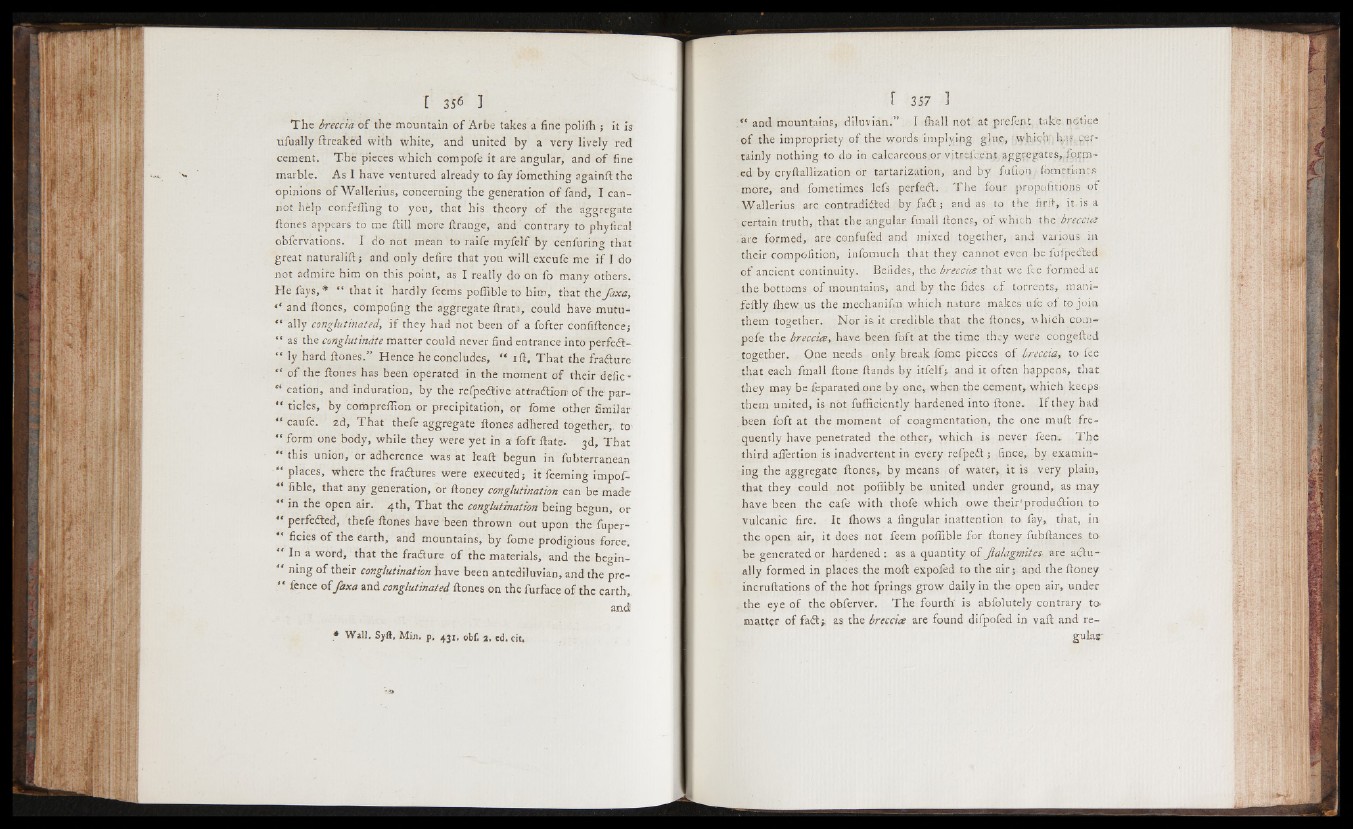
T he breccia o f the mountain o f Arbe takes a fine poliih ; it is
ufually ftreakéd with white, and united by a very lively red
cement. The pieces which compofe it are angular, and of fine
marble. As I have ventured already to fay fomething againH the
opinions o f Wallerius, concerning the generation o f fand, I cannot
help cor.feffing to yon, that his theory o f the aggregate
ilones appears to me Hill more Hrange, and contrary to phytical
obfervations. I do not mean to raife myfelf by cenfuring that
great naturaliil; and only defire that you will excufe me i f I do
not admire him on this point, as I really do on fo many others.
He fays, * “ that it hardly feems poffible to him, that the faxa,
* and ilones, compofing the aggregate Hrata, could have mutu-
“ ally conglutinated, i f they had not been of a fofter confiflence;
“ as the conglutinóte matter could never find entrance into perfeét-
“ ly hard Hones.” Hence he concludes, gj ift. That the fraéture
“ o f the ilones has been operated in the moment of their defic-
“ cation, and induration, by the refpetHive attraction o f the par-
“ tides, by compreffion or precipitation, of fome other fimilar
“ caufe. zd, That thefe aggregate ilones adhered together, to
“ form one body, while they were yet in a foft Hate. 3d, That
this union, or adherence was at leait begun in iubterranean
“ places, where the fraCtures were executed; it feeming impof-
fible, that any generation, or iloney conglutination can be made
“ in the open air. 4th, That the conglutination being begun, or
“ perfected, thefe ilones have been thrown out upon the fuper-
ficies o f the earth, and mountains, by fome prodigious force.
‘ In a word, that the fraiture o f the materials, and the begin-
“ mng o f their conglutination have been antediluvian, and the pre-
fence o í faxa and conglutinated ilones on the furface of the earth,
and
* Wall. Syft, Min. p. 431. obC a. ed. cit.
|§ and mountains, diluvian.” I ihall not' at prefept. take notice
o f the impropriety o f the words implying g lu e ,7whichf: hqjscertainly
nothing to do in calcareous.or vitreficen-t.aggregates^jb^m-
ed by cryilallization or tartarization, and by fufioo ibmeti-mes
more, and fome times lefs perfeCt. The four propofitions o f
Wallerius are contradicted by.faCt; andas to the fiyil, it is a
certain truth, that the angular fmall ilones, o f which the breccia
áre formed, are confufed and mixed together, and various 111
their compofition, infomuch that they cannot even be fufpeCted
o f ancient continuity. Befides, the breccia that we fee formed at
the bottoms o f mountains, and by the fides of torrents, tnani-
feilly iliew us the mechanifar which nature makes ufe oí to join
them together. Nor is it credible that the Hones, which compofe
the breccia, have been foft at the time they were congeHed
together. One needs only break fome pieces o f breccia, to lee
that each fmall Hone Hands by itfelf; and it often happens, that
they may be feparated one by one, when the cement, which keeps'
them united, is not fufficiently hardened into Hone. I f they had
been foft at the moment o f coagmentation, the one muH frequently
have penetrated the other, which is never feen. The
third afiertion is inadvertent in every refpeCt; fince, by examining
the aggregate Hones, by means o f water, it is very plain,
that they could not poffibly be united under ground, as may
have been the cafe with thofe which owe their'produ&ion to
vulcanic fire. It ihows a fingular inattention to fay, that, in
the open air, it does not feem poffible for Honey fubflances to
be generated or hardened: as a quantity o f Jlalagmites are actually
formed in places the moH expofed to the air; and the Honey
incruflations o f the hot fprings grow daily in the open air, under
the eye o f the obferver. The fourth is abfolutely contrary to-
matter of fa il; as the breccia are found difpofed in vafi and re